Glowing oobleck is the perfect hands-on sensory activity for Fall! It’s mesmerizing and magical, and even adults won’t be able to resist grabbing a handful of this glowing Non-Newtonian fluid!
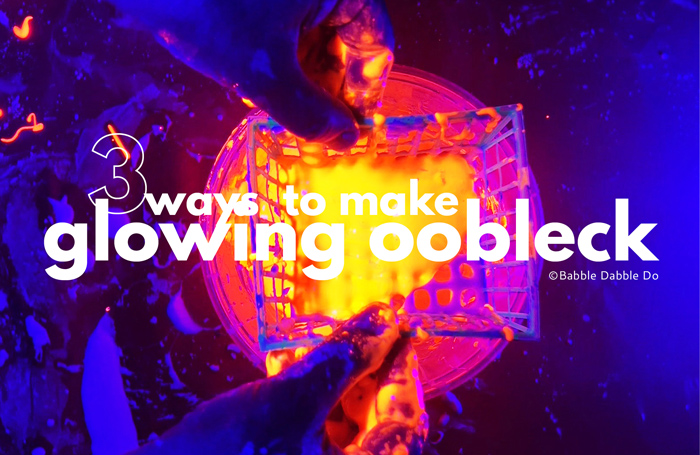
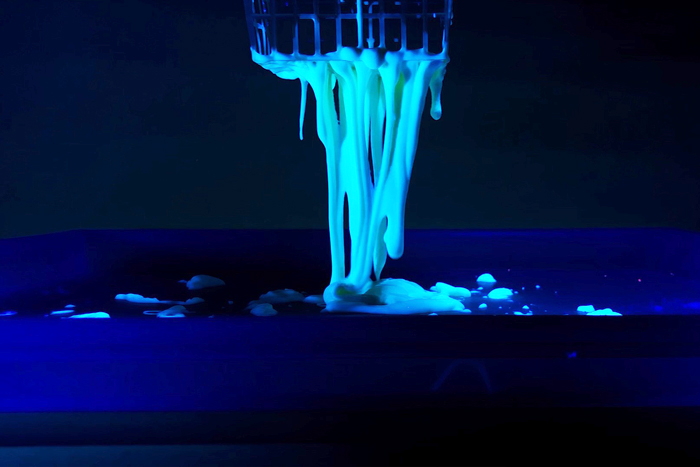
This post contains affiliate links.
Longtime readers of this blog know that oobleck is sort of an obsession of mine and for good reason: Kids love it and it is so easy to make! It’s the ultimate play recipe in my humble opinion. We have turned it into fountains, mixed it with our feet, and made it dance. And now we are going to make it glow!
There are several ways you can make oobleck glow and today I will share 3 different methods we have used, each featuring a different glowing ingredient.
If you haven’t read our How to Make Oobleck post you may want to check that out first for a few tips on the right consistency for oobleck. If you want to learn more about the science behind oobleck itself also visit this post!
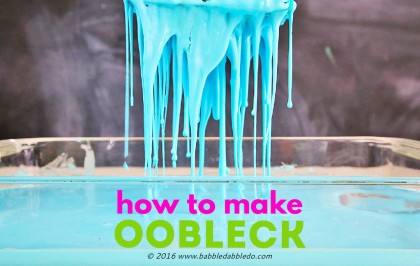
Please note: You will need a black light for this project! I invested in this one a couple years ago and it has worked really well for projects like this. In case you are thinking why buy a light for one project, I’ve got a few more glowing ideas for you at the end of the post where you can use your black light for more creative glowing fun! You can also use a UV flashlight as a less costly alternative.
The science behind glowing oobleck
The reason all three glowing oobleck methods work starts with Ultraviolet (UV) Light. Black lights emit a type of light called long wave ultraviolet light and certain materials react to this type of light, causing them to fluoresce or glow. There are both natural materials including corals, jellyfish, some arachnids, and minerals and man-made chemicals including fluorescent pigments that glow in the presence of UV light.
General Glowing Oobleck Materials
- Cornstarch
- Black Light This is my favorite one on Amazon
- Tonic Water (Method 1)
- Highlighter (Method 2)
- Fluorescent Paint (Method 3)
- Mixing Bowl, measuring cups, and spoons
Glowing Oobleck Method 1
Method 1 utilizes a common drink that just happens to glow…
Method 1 Ingredients
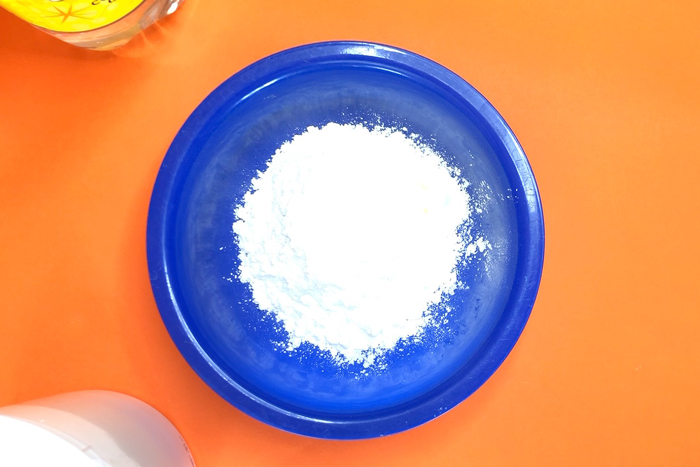
- 1 Cup Cornstarch
- 1/2 Cup Tonic Water
- Mixing Bowl, measuring cups, and spoons
- Tray
Method 1 Instructions
- Step One Pour 1 cup cornstarch into a bowl.
- Step Two Add 1/2 cup of water and stir to combine. If the oobleck is too thick add more tonic water 1 tablespoon at a time.
- Step Three Go into a dark room and turn on your black light. Place the oobleck near the black light and watch it glow! If you have the bottle of tonic water nearby hold it near the black light and watch it light up!
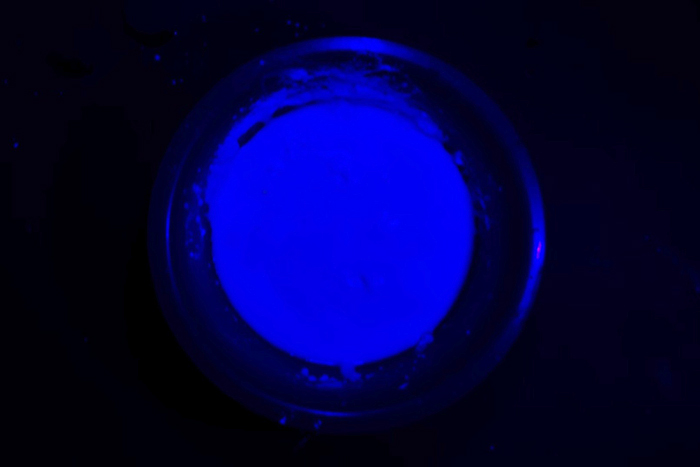
What makes it glow?
This method is the least bright of the three but learning that tonic water glows is a fun fact all in of itself! Tonic water contains quinine. Quinine is a chemical compound derived from the bark of the Cinchona tree. Quinine is used as a medicine to treat malaria and is dissolved in tonic water to give it a bitter flavor.
Tonic water was originally developed to prevent malaria but eventually gained popularity as a drink. In any case quinine fluoresces (glows) under ultraviolet light. Substituting tonic water for tap water in our oobleck recipe makes the oobleck fluoresce or glow under black light.
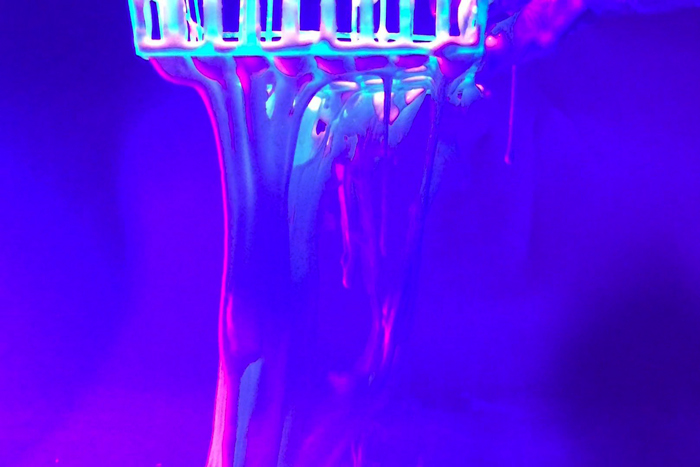
Glowing Oobleck Method 2
Method 2 takes a little bit of planning but easy to make using something you probably have laying around the house: a highlighter!
Tip: A fun variation on this activity is to make the oobleck in a dark room with a blacklight on. You will be able to watch the highlighter water “light up” the oobleck as you stir it. Just be sure to have everything in front of you so you don’t have to move around in the darkened room.
Method 2 Ingredients
- 1 Cup Cornstarch
- 1 Cup Water
- Jar
- Highlighter
- Mixing Bowl, measuring cups, and spoons
- Tray
Method 2 Instructions
- Step One Pour 1 cup of water into a jar. Remove the ink “stick” from inside a highlighter. Place the highlighter ink stick into the jar and soak overnight.
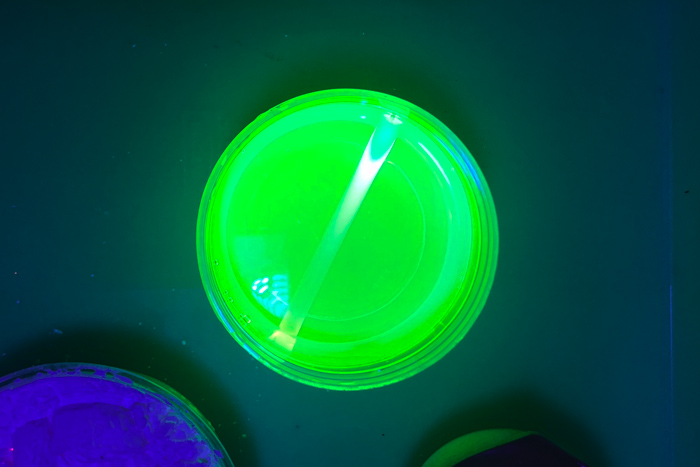
- Step Two Pour 1 cup cornstarch into a bowl
- Step Three Add 1/2 cup of highlighter water and stir to combine. If the oobleck is too thick add more highlighter water 1 tablespoon at a time.
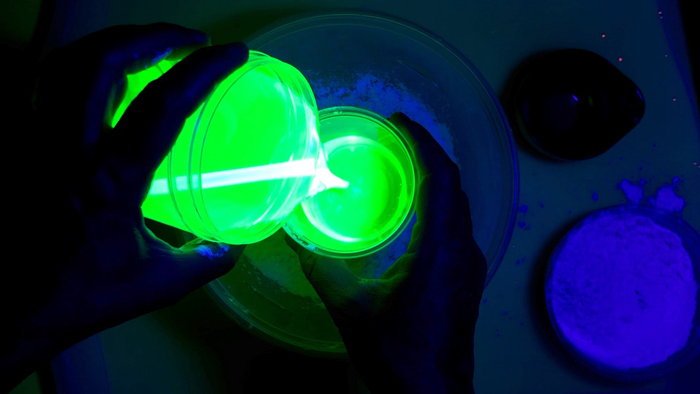
- Step Four Go into a dark room and turn on your black light. Place the oobleck near the black light and watch it glow!
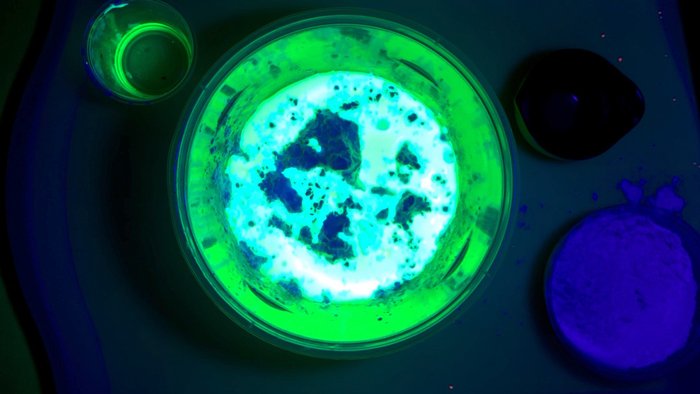
What makes it glow?
Highlighter ink is fluorescent. Fluorescent colors are able to absorb and reflect more light than traditional colors. They convert both light of a dominant wavelength AND wavelengths that are much lower on the visible spectrum. That means that fluorescent colors are bright and visible under typical lighting sources but when you add in an ultraviolet light source the previously invisible wavelengths become visible and glow. This is a great overview of fluorescent color.
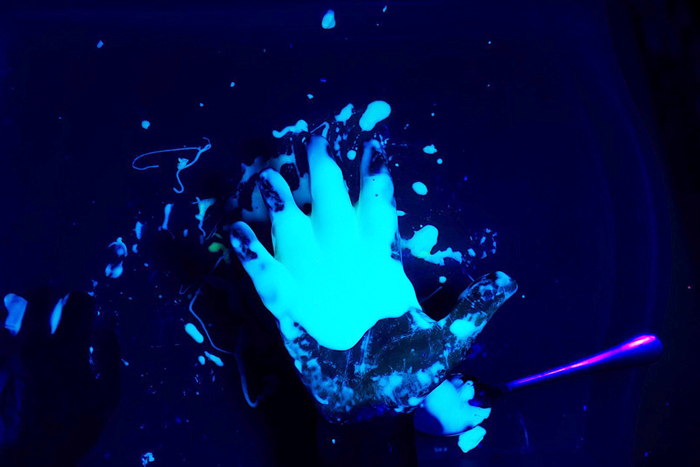
Glowing Oobleck Method 3
Method 3 is my favorite because it so bright!!! It does require you to have fluorescent paint but it will blow your mind! I also recommend making this in a dark room with the black light on for an extra wow when mixing!
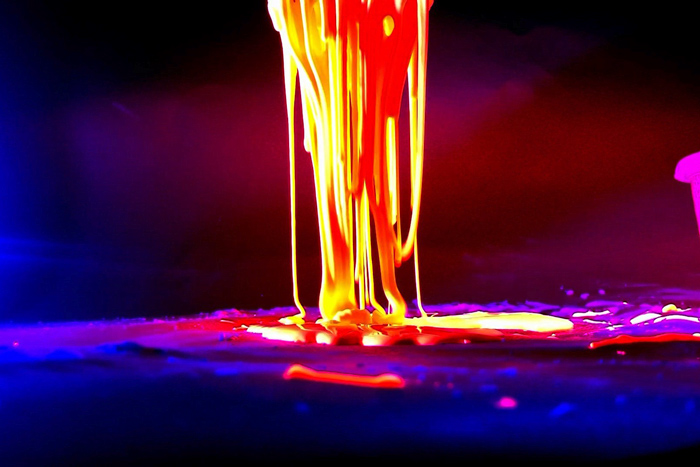
Method 3 Ingredients
- 1 Cup Cornstarch
- 1/2 Cup Water
- Fluorescent/Neon Paint It does not have to be glow in the dark paint. Any neon paint glows under UV light! This is a great set of fluorescent paints.
- Mixing Bowl, measuring cups, and spoons
- Tray
Method 3 Instructions
- Step One Pour 1 cup cornstarch into a bowl.
- Step Two Add 1/2 cup of water and stir to combine. If the oobleck is too thick add more water 1 tablespoon at a time.
- Step Three Add a good squeeze of neon paint and stir to combine.
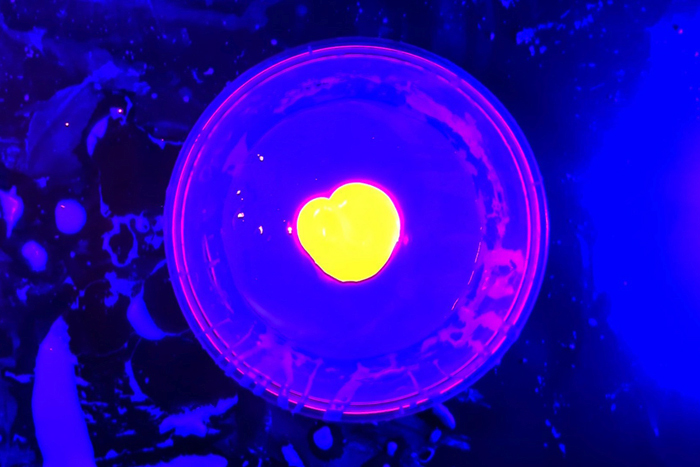
- Step Four Go into a dark room and turn on your black light. Place the oobleck near the black light and watch it glow!
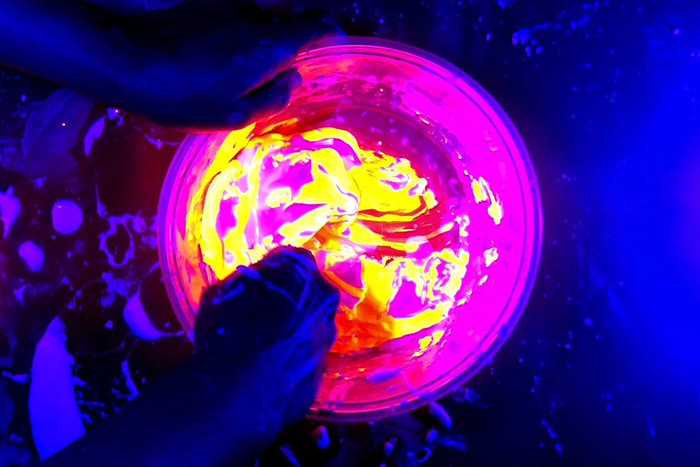
What makes it glow?
Method 3 glows for the same reason that our highlighter version glows, the paint is fluorescent and has wavelengths of light that are invisible until exposed to ultraviolet light. Under the presence of UV light these pigments glow intensely!
Fluorescent vs. Phosphorescent
Interestingly enough fluorescent materials are NOT phosphorescent. Phosphorescent materials absorb and store light energy and are able to emit that energy even after a light source is removed. Think about a glow in the dark t-shirt, the glowing elements are made with phosphorescent materials. You “charge” the shirt by exposing it to a light source and then go into a completely dark room and the shirt emits light, even without a light source. Fluorescent colors do not store energy. As soon as the UV light source is removed they stop glowing.
More Glowing Fun!
I cannot tell you how much fun it is to create and play with glowing obbleck and other glowing materials! Here are more ideas for glowing STEAM projects:
Glowing Density Towers, Glow in the Dark Art, Hidden Pictures
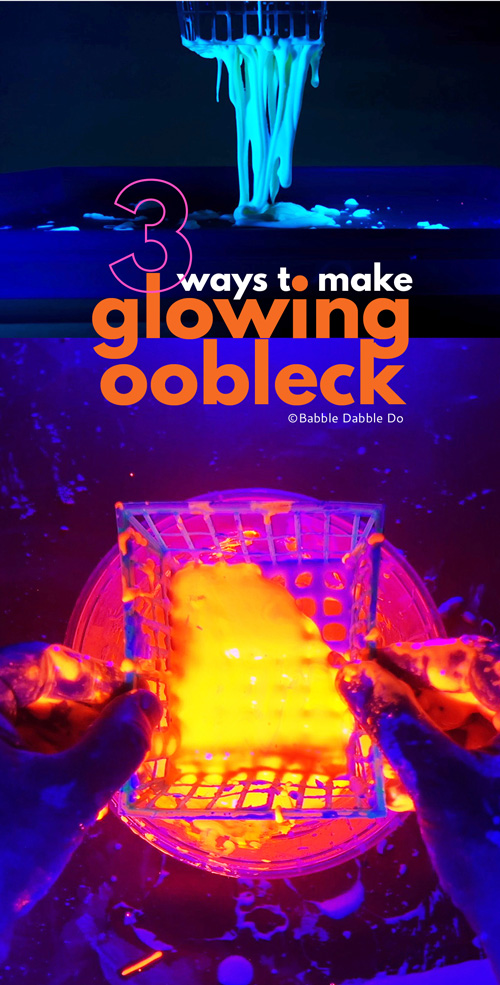
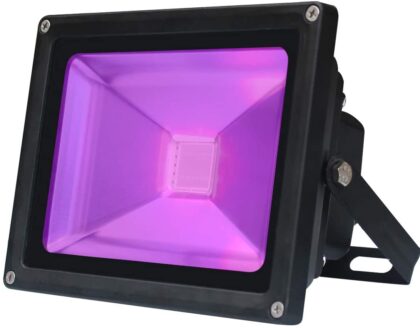
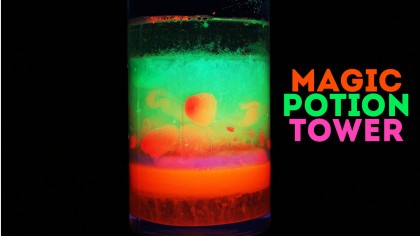
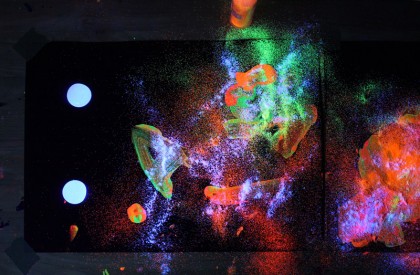
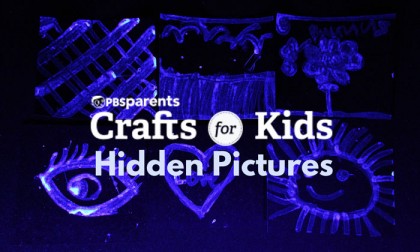
Leave a Reply